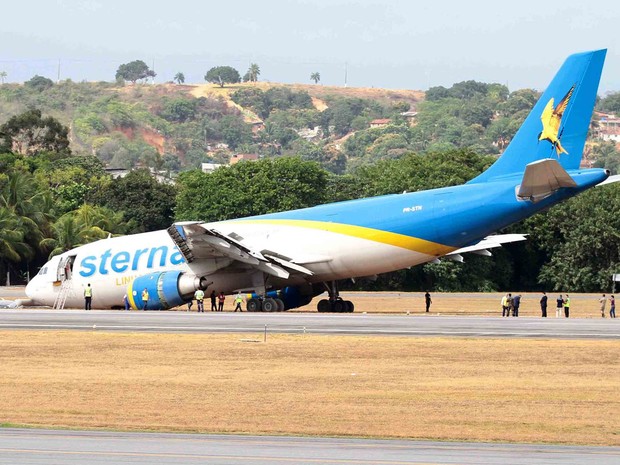In this part, you will tell me what you can see in this picture and what you think is happening in it. After that, I will ask you some questions. Look at the picture carefully. You may take a few moments to think before you start talking.
Are the instructions clear?
SUGGESTED INTERACTION:
ICAO 5:
Right off the bat, we’ve got here a runway excursion!
This picture depicts me, a twin-engined cargo jet, operated by Stern Airlines, which hands down experienced a runway excursion.
According to my imagination, upon closer examination of this situation, it seems that the nose gear collapsed upon touchdown.
Consequently, this Airbus A-300 veered off the runway and came to a halt with both main gear and aircraft nose on the soft ground.
To the best of my knowledge about this event, the crew deployed the left escape slide, the slide inflated but detached from the aircraft before the crew could exit the aircraft, and the crew subsequently evacuated the aircraft via ladders.
Two fire trucks are offering assistance, and everything appears to be under control.
It is evident that the aircraft sustained substantial damage and will be towed to the hangar to undergone thorough inspection and maintenance.
ICAO 4: In this picture I can see a twin-engined cargo jet aircraft that had a runway excursion.
The nose landing gear is collapsed and the main door is opened, I believe the crew got evacuate the aircraft without serious injuries.
There are two fire trucks providing assistance and everything seems to be under control.
Examiner: What do you think happened before this picture was taken?
SUGGESTED INTERACTION:
ICAO 5: Before this picture has been taken, I imagine that the crew could have lost control of the aircraft during the landing roll due to a reverse asymmetric thrust and the aircraft veered off the right side of the runway as result.
ICAO 4: Before this picture was taken the pilots had problem to lock the nose landing gear and during the touch down the nose gear collapsed and the aircraft veered off the runway.
Examiner: What do you think will happen next?
SUGGESTED INTERACTION:
ICAO 5: Next, consequently, the runway will be closed for a couple of hours as result of the occurrence until the aircraft be removed and the runway be meticulously inspected to get rid of all the debris
ICAO 4: The aircraft will be moved from the runway to restart the airport operations as soon as possible.
Examiner: What are the consequences of runway excursions?
SUGGESTED INTERACTION:
ICAO 5: Runway excursions can have various consequences, ranging from minor to severe, depending on factors such as the type and size of the aircraft, weather conditions, and the response of the flight crew and emergency services.
I have in mind some potential consequences, such as:
Aircraft Damage;
Injuries or Fatalities;
Disruption of Airport Operations;
Financial Impact;
Among others…
ICAO 4: Runway excursion can cause serious damages to the aircraft, injuries to the passengers and crew and lead to a fatal accident, especially in case of a violent impact to buildings.
Examiner: What can pilots do to reduce the risk of runway excursions?
SUGGESTED INTERACTION:
ICAO 5: Pilots can take various measures to reduce the risk of runway excursions, for example:
Follow the company’s SOPs or Aircraft’s POH during all phases of flight, including approach, landing, and rollout.
Maintain a high level of situational awareness, especially during critical phases of flight such as landing.
Other than that, Pilots should carefully assess weather conditions before and during the approach and landing phases. Adverse weather, such as strong crosswinds, low visibility, or slippery runway surfaces, can increase the risk of runway excursions.
In addition, regular training, including simulator sessions, allows pilots to practice and improve their skills in handling various scenarios, including those that could lead to runway excursions.
And Finally, If conditions are unfavorable or if the approach becomes unstabilized, pilots should not hesitate to initiate a go-around. This decision can help avoid a potentially unsafe landing and provide the opportunity to re-establish a stable approach.
ICAO 4: To reduce the risk of runway excursions, pilots need to check if the aircraft is in good condition with updated maintenance.
Another thing to be done is always check if the airport is suitable to the operation as well as, check if the weather and the runway are in nice conditions.
Now, I am going to read a statement to you and then you will have to tell me to what extent you agree or disagree with it.
“Most of runway excursions can be avoided if an appropriate go around procedure is conducted”
SUGGESTED INTERACTION
ICAO 5: I absolutely agree with this statement.
Going around and follow a missed approach procedure and attempt another approach in case of poor weather conditions is totally recommendable.
Furthermore, going around in case of problems with the landing gear or even to avoid some animals or other aircraft on the runway is essential for the safety of the operations.
In some cases, going around and heading to the nearest suitable airport is the best recommendable action.
ICAO 4:I agree with that statement.
In my opinion, every pilot should go around in case of:
Bad weather conditions;
Problems with the hydraulics and landing gear;
Some animals, vehicles or other aircraft on the runway.
It is highly recommended to attempt another landing and, if not possible, alternate to the nearest suitable airport.
Se você gostou desse post do Call to Fly, compartilhe utilizando os canais de Mídia!!
Abraço!! Rumo ao topo!
Leandro Araujo
